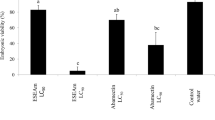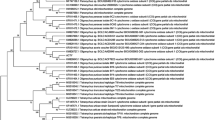Abstract
Tetranychus urticae Koch (Acari: Tetranychidae) is a major pest of several agricultural crops and Neoseiulus californicus (McGregor) (Acari: Phytoseiidae) is an important natural enemy of this pest mite. The objective of the study was to evaluate the effect of spiromesifen on the development and reproduction of T. urticae, and to assess the influence of spiromesifen and other acaricides on the population growth rates of the spider mite and its predator, N. californicus. Toxicity tests with spiromesifen at different life stages of T. urticae indicated that eggs less than 72 h old were more sensitive than other development stages. The oviposition rate of T. urticae was significantly affected by spiromesifen. Experiments on the effects of spiromesifen on the growth rates of T. urticae and N. californicus indicated that spiromesifen is innocuous to the predaceous mite but highly toxic to the spider mite, leading to population suppression in 10 days. Fenpropathrin, acephate and neem oil were not harmful to N. californicus, but were not so efficient as spiromesifen in controlling T. urticae, and had significantly less influence on the population growth rates of the spider mite. Among these three products, only neem oil caused significant reduction in the growth rate of T. urticae. Chlorfenapyr, abamectin, milbemectin and diafenthiuron significantly affected the population growth rates of T. urticae and N. californicus. Spiromesifen was the most promising acaricide for managing the two-spotted spider mite, when used in combination with N. californicus.



Similar content being viewed by others
References
Abou-Awad, B. A., & El-Banhawy, E. M. (1985). Comparison between the toxicity of synthetic pyrethroids and other compounds to the predacious mite Amblyseius gossypi (Mesostigmata: Phytoseiidae). Experimental and Applied Acarology, 1, 185–191.
AGROFIT (2011) Sistema de agrotóxicos fitossanitários, do Ministério da Agricultura, Pecuária e Abastecimento. http://extranet.agricultura.gov.br/agrofit_cons/principal_agrofit_cons. Accessed 24 July 2011.
Amin, M. M., Mizell, R. F., & Flowers, R. W. (2009). Response of the predatory mite Phytoseiulus macropilis (Acari: Phytoseiidae) to pesticides and kairomones of three spider mite species (Acari: Tetranychidae), and non-prey food. Florida Entomologist, 92, 554–562.
Bretschneider, T., Fischer, R., & Nauen, R. (2007). Inhibitors of lipid synthesis. In W. Krämer & U. Schirmer (Eds.), Modern crop protection compounds (pp. 909–925). Weinheim, Germany: Wiley–VCH Verlag Gmbh & Co.
De Moraes, G. J., & Flechtmann, C. H. W. (2008). Manual de acarologia: Acarologia básica e ácaros de plantas cultivadas no Brasil. Ribeirão Preto, S.P., Brazil: Holos.
Erler, F. (2004). Oviposition deterrency and deterrent stability of some oily substances against the pear psylla Cacopsylla pyri. Phytoparasitica, 32, 479–485.
Esteves Filho, A. B., de Oliveira, J. V., & Gondim Júnior, M. G. C. (2008). Toxicidade de acaricidas sobre diferentes estágios de vida de Tetranychus urticae Koch (Acari: Tetranychidae) em mamoeiro. BioAssay, 3(6). http://www.bioassay.org.br/articles/3.6/BA3.6.pdf. Accessed 10 December 2010.
Gurusubramanian, G., & Krishna, S. S. (1996). The effects of exposing eggs of four cotton insect pests to volatiles of Allium sativum (Liliaceae). Bulletin of Entomological Research, 86, 29–31.
Knight, A. L., Beers, E. H., Hoyt, S. C., & Riedl, H. (1990). Acaricide bioassay with spider mites (Acari: Tetranychidae) on pome fruits: evaluation of methods and selection of discrimination concentrations for resistance monitoring. Journal of Economic Entomology, 83, 1752–1760.
LeOra Software. (1987). Polo-PC: A user’s guide to probit or logit analysis. Berkeley, CA, USA: LeOra Software Company.
Marcic, D. (2007). Sublethal effects of spirodiclofen on life history and life-table parameters of two-spotted spider mite (Tetranychus urticae). Experimental and Applied Acarology, 42, 121–129.
Michaelides, P. K., & Wright, D. J. (1997). Activity of soil insecticides on eggs of Diabrotica undecimpunctata howardi: effects on embryological development and influence of egg age. Pesticide Science, 49, 1–8.
Nauen, R., Schnorbach, H. J., & Elbert, A. (2005). The biological profile of spiromesifen (Oberon®) - A new tetronic acid insecticide/acaricide. Pflanzenschutz-Nachrichten Bayer, 58, 417–440.
Nicastro, R. L., Sato, M. E., & da Silva, M. Z. (2010). Milbemectin resistance in Tetranychus urticae (Acari: Tetranychidae): selection, stability and cross-resistance to abamectin. Experimental and Applied Acarology, 50, 231–241.
Oatman, E. R., McMurtry, J. A., Gilstrap, F. E., & Voth, V. (1977). Effect of releases of Amblyseius californicus, Phytoseiulus persimilis, and Typhlodromus occidentalis on the twospotted spider mite on strawberry in southern California. Journal of Economic Entomology, 70, 45–47.
PROMIP (2010). Biological products: Neoseiulus californicus. http://www.promip.agr.br/produtos.asp?. Accessed 08 December 2010.
Sáenz-de-Cabezón, F. J., Pérez-Moreno, I., & Marco, V. (2002). Effects of triflumuron on the two-spotted spider mite, Tetranychus urticae (Acari: Tetranychidae). Experimental and Applied Acarology, 26, 71–78.
Sato, M. E., da Silva, M. Z., Cangani, K. G., & Raga, A. (2007). Seleções para resistência e suscetibilidade, detecção e monitoramento da resistência de Tetranychus urticae ao acaricida clorfenapir. Bragantia, 66, 89–95.
Sato, M. E., da Silva, M., Gonçalves, L. R., Souza Filho, M. F., & Raga, A. (2002). Toxicidade diferencial de agroquímicos a Neoseiulus californicus (McGregor) (Acari: Phytoseiidae) e Tetranychus urticae Koch (Acari: Tetranychidae) em morangueiro. Neotropical Entomology, 31, 449–456.
Sato, M. E., da Silva, M. Z., Raga, A., & Souza Filho, M. F. (2005). Abamectin resistance in Tetranychus urticae Koch (Acari: Tetranychidae): Selection, cross-resistance and stability of resistance. Neotropical Entomology, 34, 1–8.
Sato, M. E., da Silva, M. Z., Souza Filho, M. F., Matioli, A. L., & Raga, A. (2007). Management of Tetranychus urticae (Acari: Tetranychidae) in strawberry fields with Neoseiulus californicus (Acari: Phytoseiidae) and acaricides. Experimental and Applied Acarology, 42, 107–120.
Shrinivas, K., & Shamim, M. (2008). Formulating neem oil emulsion as potent agrochemicals using a binary emulsifier system. Journal of Dispersion Science and Technology, 29, 919–929.
Stark, J. D., & Banks, J. E. (2003). Population-level effects of pesticides and other toxicants on arthropods. Annual Review of Entomology, 48, 505–519.
Stumpf, N., & Nauen, R. (2002). Biochemical markers linked to abamectin resistance in Tetranychus urticae (Acari-Tetranychidae). Pesticide Biochemistry and Physiology, 72, 111–121.
Van de Vrie, M., McMurtry, J. A., & Huffaker, C. B. (1972). Ecology of tetranychid mites and their natural enemies: A review. III. Biology, ecology, and pest status, and host-plant relations of tetranychids. Hilgardia, 41, 387–403.
Van Pottelberge, S., Khajehali, J., van Leeuwen, T., & Tirry, L. (2009). Effects of spirodiclofen on reproduction in a susceptible and resistant strain of Tetranychus urticae (Acari: Tetranychidae). Experimental and Applied Acarology, 47, 301–309.
Wachendorff, U., Nauen, R., Schnorbach, H. J., Rauch, N., & Elbert, A. (2002). The biological profile of spirodiclofen (Envidor®) - a new selective tetronic acid acaricide. Pflanzenschutz-Nachrichten Bayer, 55, 149–176.
Acknowledgments
The authors would like to thank FAPESP (São Paulo Research Foundation) for funding this research (Process # 2007/08612-4) and for the scholarship awarded to Roberto L. Nicastro (Process # 2007/02748-1). We would also like to thank CNPq-Brazil (The National Council for Scientific and Technological Development) for providing the scholarship to Bruce Veronez and the research fellowship to the first and third authors.
Author information
Authors and Affiliations
Corresponding author
Rights and permissions
About this article
Cite this article
Sato, M.E., da Silva, M.Z., Raga, A. et al. Spiromesifen toxicity to the spider mite Tetranychus urticae and selectivity to the predator Neoseiulus californicus . Phytoparasitica 39, 437–445 (2011). https://doi.org/10.1007/s12600-011-0189-x
Received:
Accepted:
Published:
Issue Date:
DOI: https://doi.org/10.1007/s12600-011-0189-x




